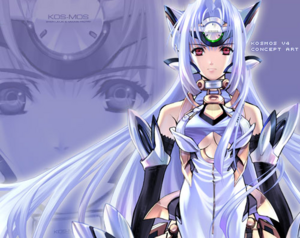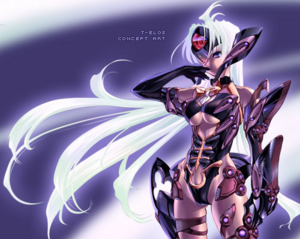September 6, 2007
Xenosaga: Episode III
 It's been a long time since I finished a video game, and there were several points in time when I didn't play for a week or more, but the final chapter of the epic saga is done and I do believe Xenosaga: Episode III to be the best in the series. I'll go into technical details later, but the all of the open questions, character backgrounds, and plot twists are finally explained. But because the authors never shy away from taking as much time as necessary to tell the story, it doesn't at all feel rushed or artificial. This time, the lengthy cut scenes did not leave me feeling impatient to continue, because everything from the previous two episodes starts to make sense and held my interest. I think they also made a conscious decision to leave out cut scenes or portions of cut scenes that did not reveal any new information, or at least hint at something that you want to know.
It's been a long time since I finished a video game, and there were several points in time when I didn't play for a week or more, but the final chapter of the epic saga is done and I do believe Xenosaga: Episode III to be the best in the series. I'll go into technical details later, but the all of the open questions, character backgrounds, and plot twists are finally explained. But because the authors never shy away from taking as much time as necessary to tell the story, it doesn't at all feel rushed or artificial. This time, the lengthy cut scenes did not leave me feeling impatient to continue, because everything from the previous two episodes starts to make sense and held my interest. I think they also made a conscious decision to leave out cut scenes or portions of cut scenes that did not reveal any new information, or at least hint at something that you want to know.
I also found the ending very satisfactory. It'd say it ranks up there as one of the best endings of any role-playing game. No doubt it helps that there is so much depth to the story. The ending sequence is quite long and feels both sad and triumphant at the same time. It does not trivialize the long journey that you, the player, had to go through in order to reach it and bring things to a conclusion. Things will be different from now on, but finally things will also be all right. It really shows a remarkable attention to quality to see such a large storyline succeed over the length of three games.
 Visually, Xenosaga: Episode III is a nice improvement over Episode II. The body movement of character is more natural during the pre-rendered scenes, and now have subtle facial expression changes that were not done before. I would say the visuals during gameplay are very similar though, and if there are any improvements they are minor enough that I could not notice them outright. The environments are much nicer, more detailed, and feel more open though. I think some effort must have been taken to try and make urban and natural environments that felt more realistic and interesting than they did before.
Visually, Xenosaga: Episode III is a nice improvement over Episode II. The body movement of character is more natural during the pre-rendered scenes, and now have subtle facial expression changes that were not done before. I would say the visuals during gameplay are very similar though, and if there are any improvements they are minor enough that I could not notice them outright. The environments are much nicer, more detailed, and feel more open though. I think some effort must have been taken to try and make urban and natural environments that felt more realistic and interesting than they did before.
The music is well done again, and there are some really nice final battle music. Not as memorable or emotional as the most famous of them all (Kefka) but I noticed them and liked the mood created by the music during those battles.
Travel is still handled the same way as before, with larger world maps that have areas you can enter, and the majority of your travel occuring via the Elsa during which time you can work on side quests. Movement through combat areas is also pretty much the same, as is the feel of the puzzles you encounter. The puzzles are new, which is good, and some of them are forms of less common types of puzzles, which is also good.
One of the most important aspects of any RPG is the combat system, and I think Episode III finally got the character battles right. You have enough EP, or you can make it so you have enough, to utilize ether skills and tech skills liberally which is the primary strategic aspect of combat. The boost and special attacks are still there, and share the same gauge. It's possible to increase the maximum of that gauge as well, which can be extremely useful. Special attacks are used to maximize awarded points at the end of combat, so it's important to use them often, which means you won't use boost often. However it is nice to have it there because boosting can make a big difference when in a pinch. Overall, you have a lot more control over things and the different tech skills provide more variety during combat. You can also use the ether skills to good effect most of the time.
The E.S. combat is still not as fun though, even if it is less boring this time because of the inclusion of special combinations depending on the attacks you use and a much greater importance on using the right types of attacks and support items during boss battles. However, regular E.S. combat might as well be holding down the attack button. The boss battles are also only difficult in that they have to be extremely drawn out. Since there really aren't a whole lot of options during E.S. combat, the only way to make them hard is to make them long, with special high-damage attacks by the boss that you need to prepare against. I would have been perfectly happy with the E.S. battle system left out, even though it isn't as bad as before.
A new skill upgrade system is also introduced this time, although it is very similar to the one from Episode II. You still spend points to unlock skills along a few set paths, but there are only two primary paths this time and you can traverse them in parallel if desired. However, completing a primary path gives you a special master skill which can be very useful. At certain times during the story you can also find items that will unlock additional EX skills. These skills do not require you to follow a path to obtain them, and you can learn them at any time provided you have enough skill points. These skills let you give a character a useful auxiliary skill that doesn't have anything to do with their primary paths, or taken as a whole may let you adjust the combat or support options available to that character in a significant way. I found this skill system to be less annoying and confusing, and more flexible, than the previous ones.
Posted by josuah at September 6, 2007 2:41 AM UTC+00:00
Trackback Pings
TrackBack URL for this entry:
http://www.wesman.net/cgi-bin/mt/mt-tb.cgi/1274

 Nami & Kiba - Away From Home
Nami & Kiba - Away From Home Goodbye Ellie
Goodbye Ellie Evangelion Mini Cooper S Clubman
Evangelion Mini Cooper S Clubman Married to Christina
Married to Christina
Comments
Post a comment
Thanks for signing in, . Now you can comment. (sign out)
(If you haven't left a comment here before, you may need to be approved by the site owner before your comment will appear. Until then, it won't appear on the entry. Thanks for waiting.)